Communication Processes in Business: Social Media, Culture, Conflict
VerifiedAdded on 2023/06/10
|8
|2007
|68
Report
AI Summary
This report examines key communication processes within a business context, focusing on social media, intercultural communication, and conflict resolution. Through an interview-based approach, the report explores the significance of social media for business growth, including its role in market share capture, customer feedback, and brand loyalty. It also addresses the advantages and disadvantages of social media use in organizations. The report further delves into intercultural communication, highlighting its importance in fostering understanding and preventing cultural shock, while also acknowledging potential challenges like language barriers and ethnocentrism. Finally, it discusses conflict resolution as a crucial communication process for maintaining a positive work environment, enhancing productivity, and addressing deeper organizational issues, suggesting measures such as conflict resolution training and improved communication channels. The report uses Tesco Plc as an example.
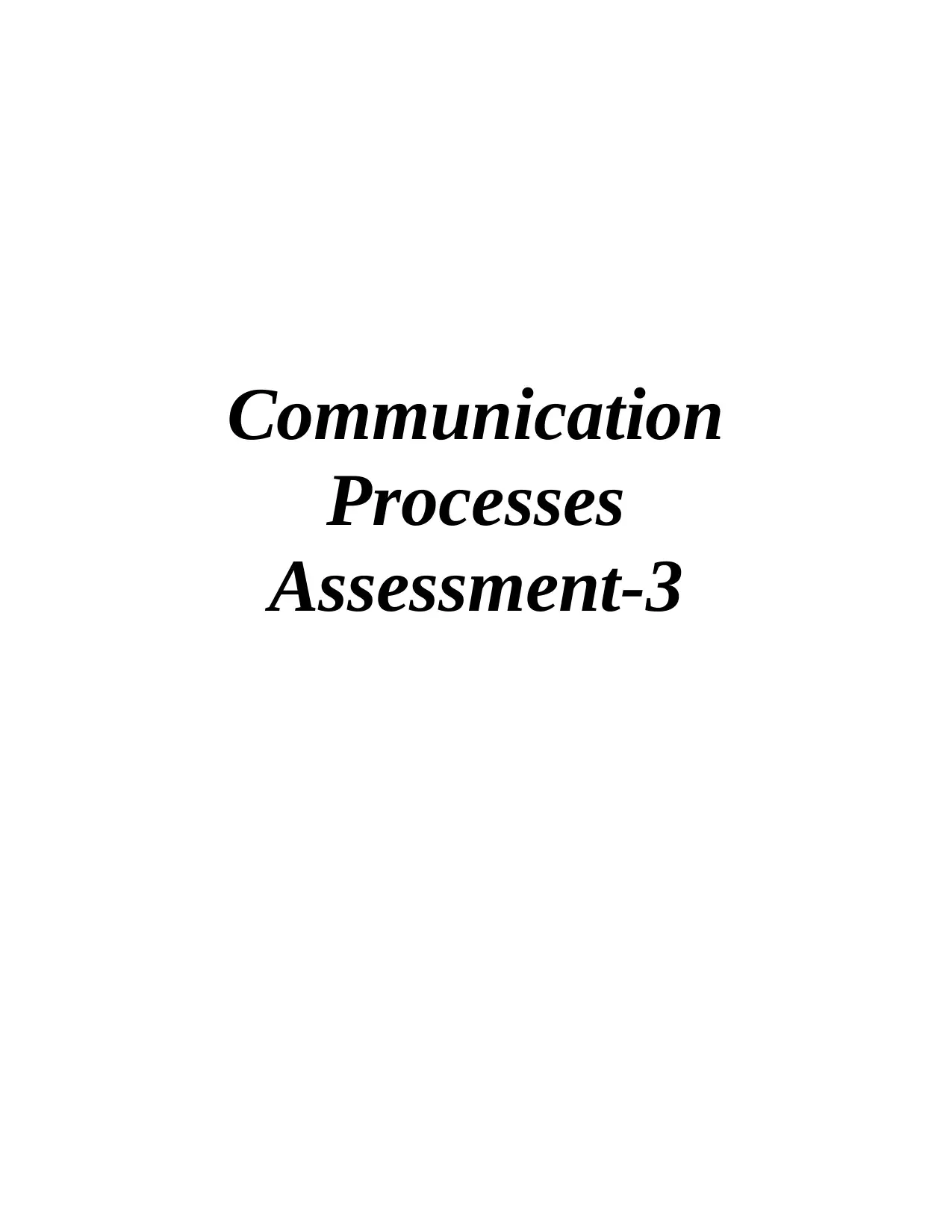
Communication
Processes
Assessment-3
Processes
Assessment-3
Paraphrase This Document
Need a fresh take? Get an instant paraphrase of this document with our AI Paraphraser
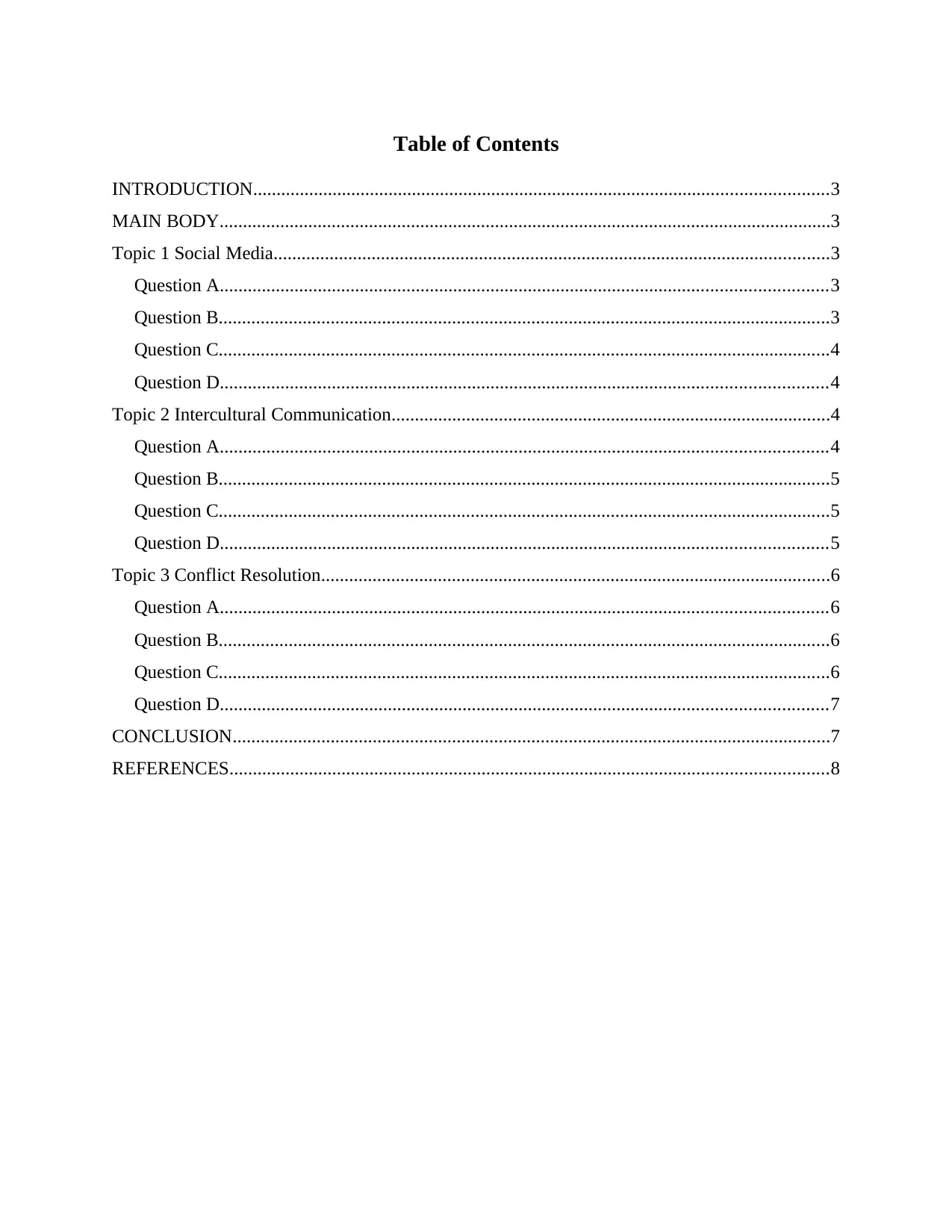
Table of Contents
INTRODUCTION...........................................................................................................................3
MAIN BODY...................................................................................................................................3
Topic 1 Social Media.......................................................................................................................3
Question A..................................................................................................................................3
Question B...................................................................................................................................3
Question C...................................................................................................................................4
Question D..................................................................................................................................4
Topic 2 Intercultural Communication..............................................................................................4
Question A..................................................................................................................................4
Question B...................................................................................................................................5
Question C...................................................................................................................................5
Question D..................................................................................................................................5
Topic 3 Conflict Resolution.............................................................................................................6
Question A..................................................................................................................................6
Question B...................................................................................................................................6
Question C...................................................................................................................................6
Question D..................................................................................................................................7
CONCLUSION................................................................................................................................7
REFERENCES................................................................................................................................8
INTRODUCTION...........................................................................................................................3
MAIN BODY...................................................................................................................................3
Topic 1 Social Media.......................................................................................................................3
Question A..................................................................................................................................3
Question B...................................................................................................................................3
Question C...................................................................................................................................4
Question D..................................................................................................................................4
Topic 2 Intercultural Communication..............................................................................................4
Question A..................................................................................................................................4
Question B...................................................................................................................................5
Question C...................................................................................................................................5
Question D..................................................................................................................................5
Topic 3 Conflict Resolution.............................................................................................................6
Question A..................................................................................................................................6
Question B...................................................................................................................................6
Question C...................................................................................................................................6
Question D..................................................................................................................................7
CONCLUSION................................................................................................................................7
REFERENCES................................................................................................................................8
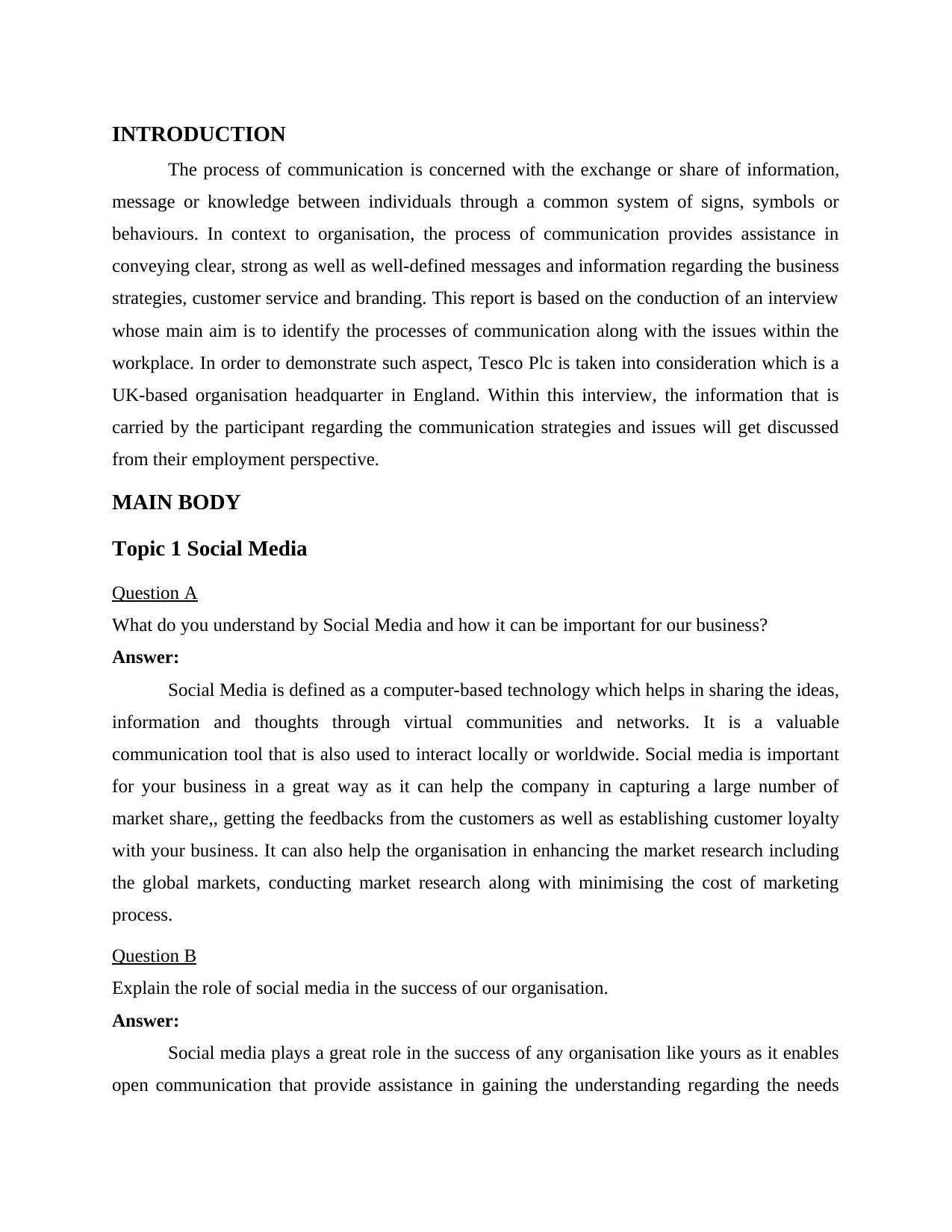
INTRODUCTION
The process of communication is concerned with the exchange or share of information,
message or knowledge between individuals through a common system of signs, symbols or
behaviours. In context to organisation, the process of communication provides assistance in
conveying clear, strong as well as well-defined messages and information regarding the business
strategies, customer service and branding. This report is based on the conduction of an interview
whose main aim is to identify the processes of communication along with the issues within the
workplace. In order to demonstrate such aspect, Tesco Plc is taken into consideration which is a
UK-based organisation headquarter in England. Within this interview, the information that is
carried by the participant regarding the communication strategies and issues will get discussed
from their employment perspective.
MAIN BODY
Topic 1 Social Media
Question A
What do you understand by Social Media and how it can be important for our business?
Answer:
Social Media is defined as a computer-based technology which helps in sharing the ideas,
information and thoughts through virtual communities and networks. It is a valuable
communication tool that is also used to interact locally or worldwide. Social media is important
for your business in a great way as it can help the company in capturing a large number of
market share,, getting the feedbacks from the customers as well as establishing customer loyalty
with your business. It can also help the organisation in enhancing the market research including
the global markets, conducting market research along with minimising the cost of marketing
process.
Question B
Explain the role of social media in the success of our organisation.
Answer:
Social media plays a great role in the success of any organisation like yours as it enables
open communication that provide assistance in gaining the understanding regarding the needs
The process of communication is concerned with the exchange or share of information,
message or knowledge between individuals through a common system of signs, symbols or
behaviours. In context to organisation, the process of communication provides assistance in
conveying clear, strong as well as well-defined messages and information regarding the business
strategies, customer service and branding. This report is based on the conduction of an interview
whose main aim is to identify the processes of communication along with the issues within the
workplace. In order to demonstrate such aspect, Tesco Plc is taken into consideration which is a
UK-based organisation headquarter in England. Within this interview, the information that is
carried by the participant regarding the communication strategies and issues will get discussed
from their employment perspective.
MAIN BODY
Topic 1 Social Media
Question A
What do you understand by Social Media and how it can be important for our business?
Answer:
Social Media is defined as a computer-based technology which helps in sharing the ideas,
information and thoughts through virtual communities and networks. It is a valuable
communication tool that is also used to interact locally or worldwide. Social media is important
for your business in a great way as it can help the company in capturing a large number of
market share,, getting the feedbacks from the customers as well as establishing customer loyalty
with your business. It can also help the organisation in enhancing the market research including
the global markets, conducting market research along with minimising the cost of marketing
process.
Question B
Explain the role of social media in the success of our organisation.
Answer:
Social media plays a great role in the success of any organisation like yours as it enables
open communication that provide assistance in gaining the understanding regarding the needs
⊘ This is a preview!⊘
Do you want full access?
Subscribe today to unlock all pages.

Trusted by 1+ million students worldwide
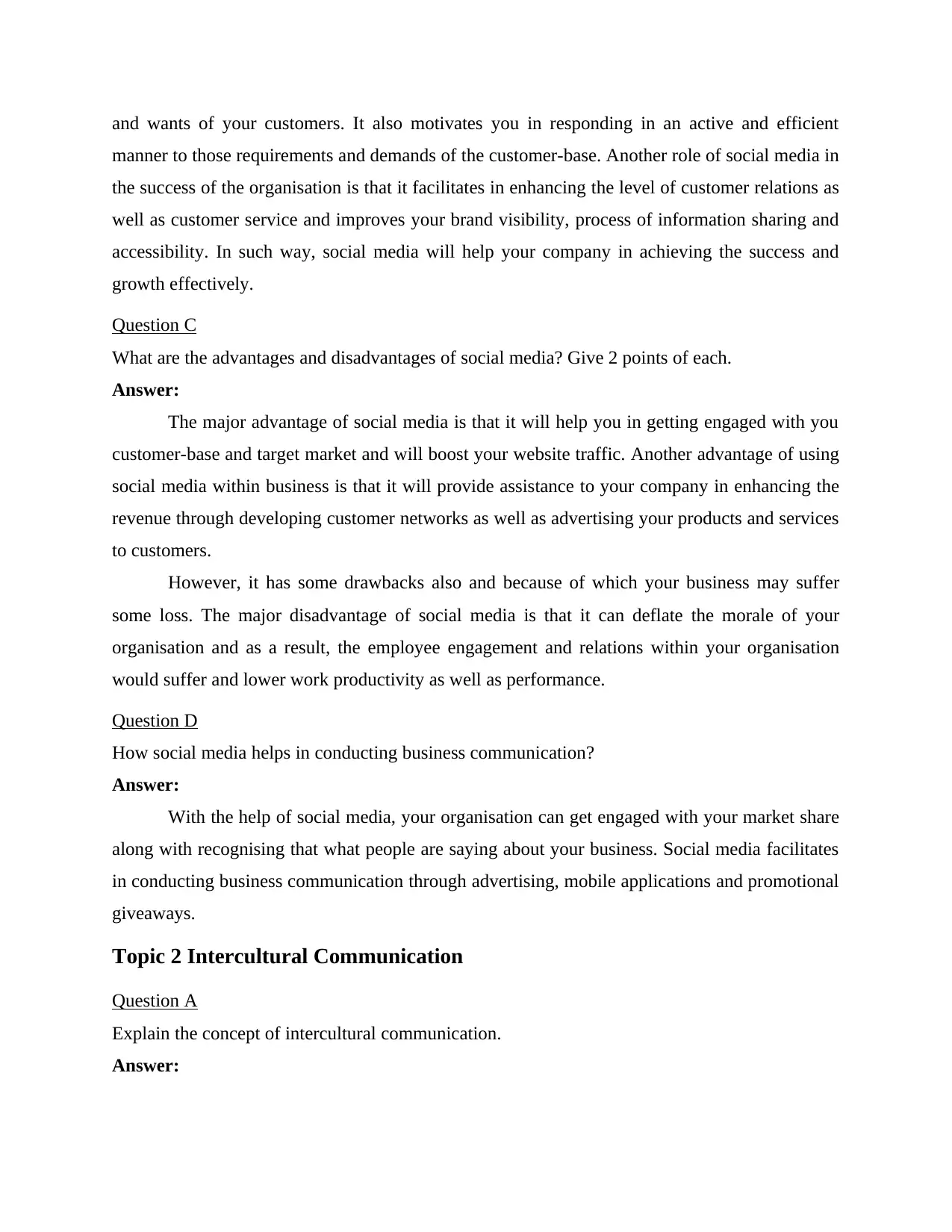
and wants of your customers. It also motivates you in responding in an active and efficient
manner to those requirements and demands of the customer-base. Another role of social media in
the success of the organisation is that it facilitates in enhancing the level of customer relations as
well as customer service and improves your brand visibility, process of information sharing and
accessibility. In such way, social media will help your company in achieving the success and
growth effectively.
Question C
What are the advantages and disadvantages of social media? Give 2 points of each.
Answer:
The major advantage of social media is that it will help you in getting engaged with you
customer-base and target market and will boost your website traffic. Another advantage of using
social media within business is that it will provide assistance to your company in enhancing the
revenue through developing customer networks as well as advertising your products and services
to customers.
However, it has some drawbacks also and because of which your business may suffer
some loss. The major disadvantage of social media is that it can deflate the morale of your
organisation and as a result, the employee engagement and relations within your organisation
would suffer and lower work productivity as well as performance.
Question D
How social media helps in conducting business communication?
Answer:
With the help of social media, your organisation can get engaged with your market share
along with recognising that what people are saying about your business. Social media facilitates
in conducting business communication through advertising, mobile applications and promotional
giveaways.
Topic 2 Intercultural Communication
Question A
Explain the concept of intercultural communication.
Answer:
manner to those requirements and demands of the customer-base. Another role of social media in
the success of the organisation is that it facilitates in enhancing the level of customer relations as
well as customer service and improves your brand visibility, process of information sharing and
accessibility. In such way, social media will help your company in achieving the success and
growth effectively.
Question C
What are the advantages and disadvantages of social media? Give 2 points of each.
Answer:
The major advantage of social media is that it will help you in getting engaged with you
customer-base and target market and will boost your website traffic. Another advantage of using
social media within business is that it will provide assistance to your company in enhancing the
revenue through developing customer networks as well as advertising your products and services
to customers.
However, it has some drawbacks also and because of which your business may suffer
some loss. The major disadvantage of social media is that it can deflate the morale of your
organisation and as a result, the employee engagement and relations within your organisation
would suffer and lower work productivity as well as performance.
Question D
How social media helps in conducting business communication?
Answer:
With the help of social media, your organisation can get engaged with your market share
along with recognising that what people are saying about your business. Social media facilitates
in conducting business communication through advertising, mobile applications and promotional
giveaways.
Topic 2 Intercultural Communication
Question A
Explain the concept of intercultural communication.
Answer:
Paraphrase This Document
Need a fresh take? Get an instant paraphrase of this document with our AI Paraphraser
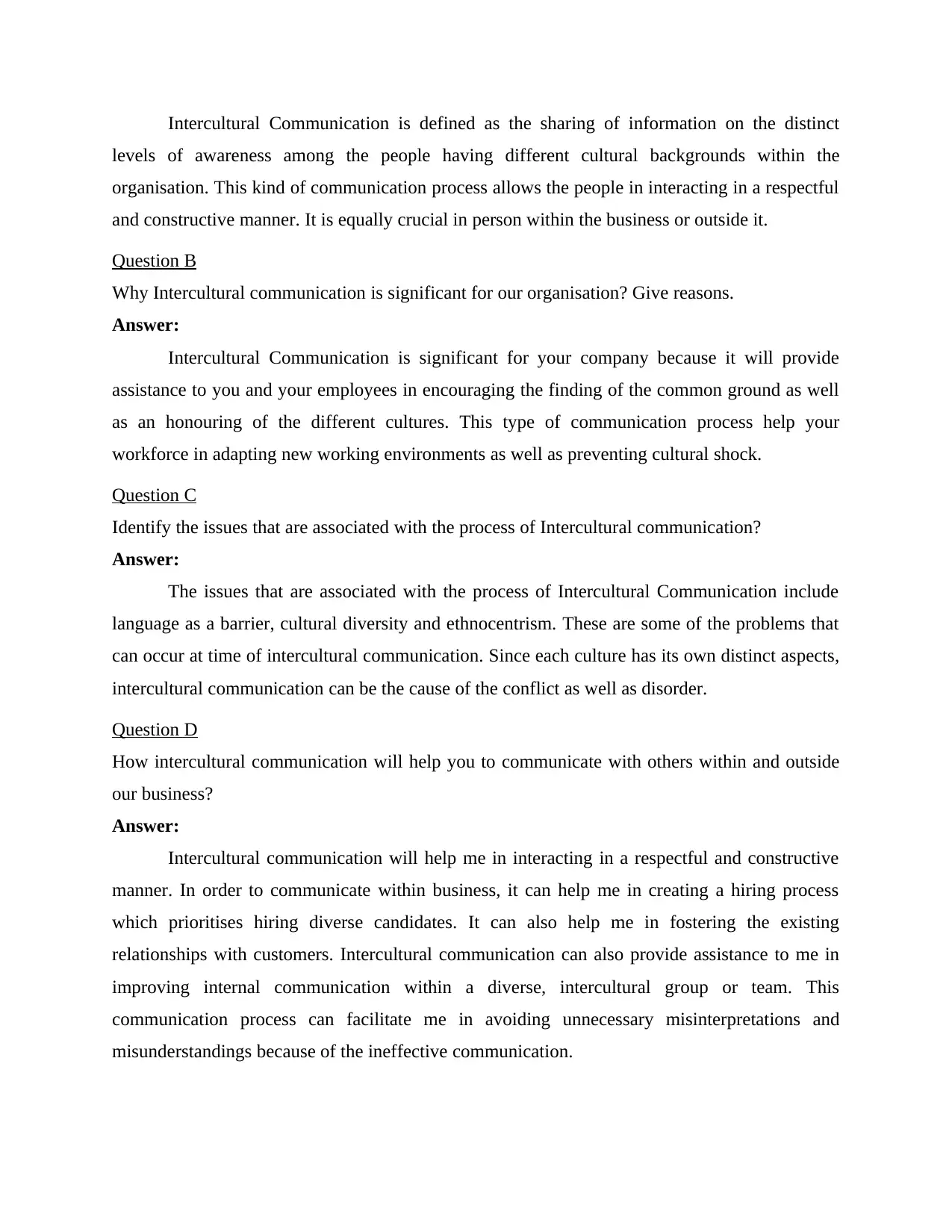
Intercultural Communication is defined as the sharing of information on the distinct
levels of awareness among the people having different cultural backgrounds within the
organisation. This kind of communication process allows the people in interacting in a respectful
and constructive manner. It is equally crucial in person within the business or outside it.
Question B
Why Intercultural communication is significant for our organisation? Give reasons.
Answer:
Intercultural Communication is significant for your company because it will provide
assistance to you and your employees in encouraging the finding of the common ground as well
as an honouring of the different cultures. This type of communication process help your
workforce in adapting new working environments as well as preventing cultural shock.
Question C
Identify the issues that are associated with the process of Intercultural communication?
Answer:
The issues that are associated with the process of Intercultural Communication include
language as a barrier, cultural diversity and ethnocentrism. These are some of the problems that
can occur at time of intercultural communication. Since each culture has its own distinct aspects,
intercultural communication can be the cause of the conflict as well as disorder.
Question D
How intercultural communication will help you to communicate with others within and outside
our business?
Answer:
Intercultural communication will help me in interacting in a respectful and constructive
manner. In order to communicate within business, it can help me in creating a hiring process
which prioritises hiring diverse candidates. It can also help me in fostering the existing
relationships with customers. Intercultural communication can also provide assistance to me in
improving internal communication within a diverse, intercultural group or team. This
communication process can facilitate me in avoiding unnecessary misinterpretations and
misunderstandings because of the ineffective communication.
levels of awareness among the people having different cultural backgrounds within the
organisation. This kind of communication process allows the people in interacting in a respectful
and constructive manner. It is equally crucial in person within the business or outside it.
Question B
Why Intercultural communication is significant for our organisation? Give reasons.
Answer:
Intercultural Communication is significant for your company because it will provide
assistance to you and your employees in encouraging the finding of the common ground as well
as an honouring of the different cultures. This type of communication process help your
workforce in adapting new working environments as well as preventing cultural shock.
Question C
Identify the issues that are associated with the process of Intercultural communication?
Answer:
The issues that are associated with the process of Intercultural Communication include
language as a barrier, cultural diversity and ethnocentrism. These are some of the problems that
can occur at time of intercultural communication. Since each culture has its own distinct aspects,
intercultural communication can be the cause of the conflict as well as disorder.
Question D
How intercultural communication will help you to communicate with others within and outside
our business?
Answer:
Intercultural communication will help me in interacting in a respectful and constructive
manner. In order to communicate within business, it can help me in creating a hiring process
which prioritises hiring diverse candidates. It can also help me in fostering the existing
relationships with customers. Intercultural communication can also provide assistance to me in
improving internal communication within a diverse, intercultural group or team. This
communication process can facilitate me in avoiding unnecessary misinterpretations and
misunderstandings because of the ineffective communication.
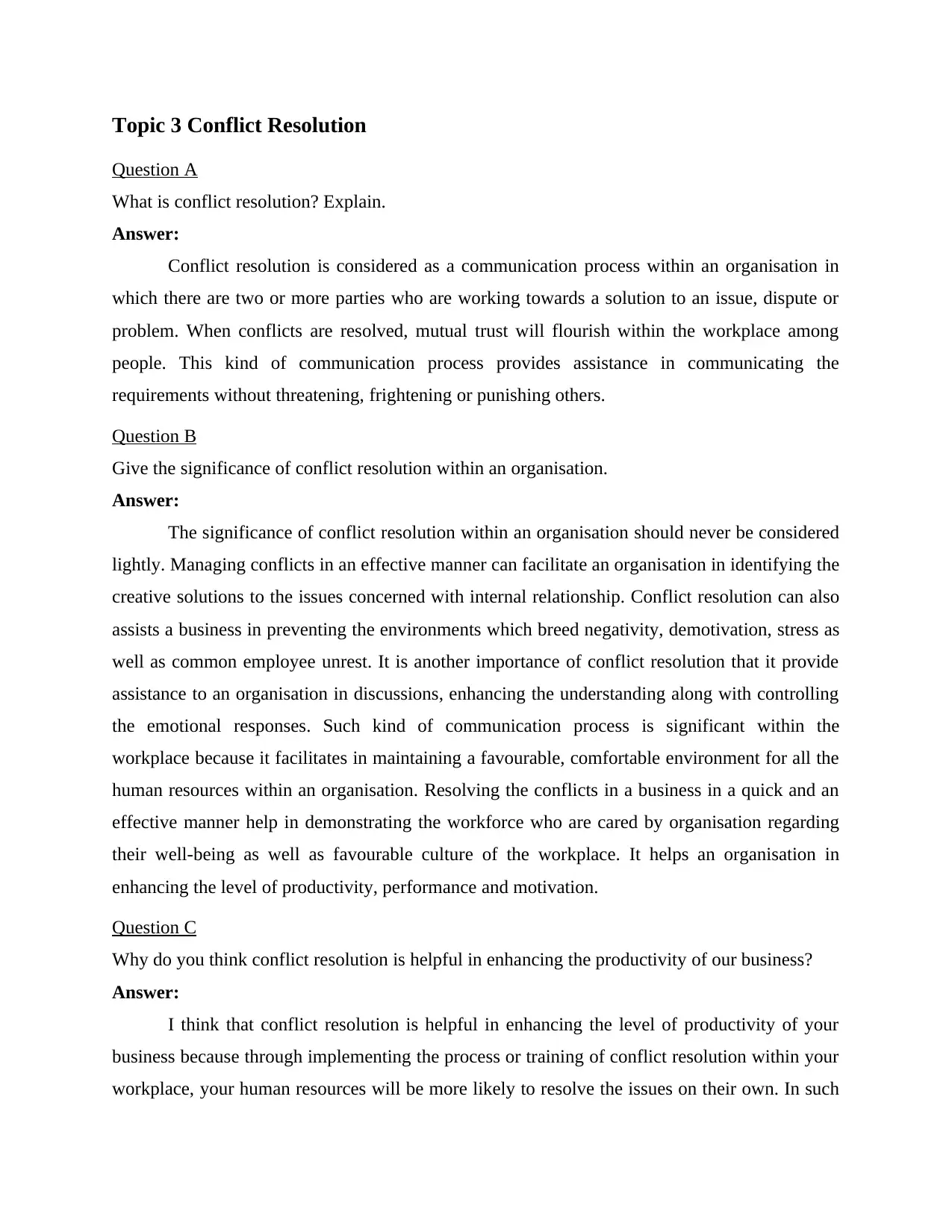
Topic 3 Conflict Resolution
Question A
What is conflict resolution? Explain.
Answer:
Conflict resolution is considered as a communication process within an organisation in
which there are two or more parties who are working towards a solution to an issue, dispute or
problem. When conflicts are resolved, mutual trust will flourish within the workplace among
people. This kind of communication process provides assistance in communicating the
requirements without threatening, frightening or punishing others.
Question B
Give the significance of conflict resolution within an organisation.
Answer:
The significance of conflict resolution within an organisation should never be considered
lightly. Managing conflicts in an effective manner can facilitate an organisation in identifying the
creative solutions to the issues concerned with internal relationship. Conflict resolution can also
assists a business in preventing the environments which breed negativity, demotivation, stress as
well as common employee unrest. It is another importance of conflict resolution that it provide
assistance to an organisation in discussions, enhancing the understanding along with controlling
the emotional responses. Such kind of communication process is significant within the
workplace because it facilitates in maintaining a favourable, comfortable environment for all the
human resources within an organisation. Resolving the conflicts in a business in a quick and an
effective manner help in demonstrating the workforce who are cared by organisation regarding
their well-being as well as favourable culture of the workplace. It helps an organisation in
enhancing the level of productivity, performance and motivation.
Question C
Why do you think conflict resolution is helpful in enhancing the productivity of our business?
Answer:
I think that conflict resolution is helpful in enhancing the level of productivity of your
business because through implementing the process or training of conflict resolution within your
workplace, your human resources will be more likely to resolve the issues on their own. In such
Question A
What is conflict resolution? Explain.
Answer:
Conflict resolution is considered as a communication process within an organisation in
which there are two or more parties who are working towards a solution to an issue, dispute or
problem. When conflicts are resolved, mutual trust will flourish within the workplace among
people. This kind of communication process provides assistance in communicating the
requirements without threatening, frightening or punishing others.
Question B
Give the significance of conflict resolution within an organisation.
Answer:
The significance of conflict resolution within an organisation should never be considered
lightly. Managing conflicts in an effective manner can facilitate an organisation in identifying the
creative solutions to the issues concerned with internal relationship. Conflict resolution can also
assists a business in preventing the environments which breed negativity, demotivation, stress as
well as common employee unrest. It is another importance of conflict resolution that it provide
assistance to an organisation in discussions, enhancing the understanding along with controlling
the emotional responses. Such kind of communication process is significant within the
workplace because it facilitates in maintaining a favourable, comfortable environment for all the
human resources within an organisation. Resolving the conflicts in a business in a quick and an
effective manner help in demonstrating the workforce who are cared by organisation regarding
their well-being as well as favourable culture of the workplace. It helps an organisation in
enhancing the level of productivity, performance and motivation.
Question C
Why do you think conflict resolution is helpful in enhancing the productivity of our business?
Answer:
I think that conflict resolution is helpful in enhancing the level of productivity of your
business because through implementing the process or training of conflict resolution within your
workplace, your human resources will be more likely to resolve the issues on their own. In such
⊘ This is a preview!⊘
Do you want full access?
Subscribe today to unlock all pages.

Trusted by 1+ million students worldwide
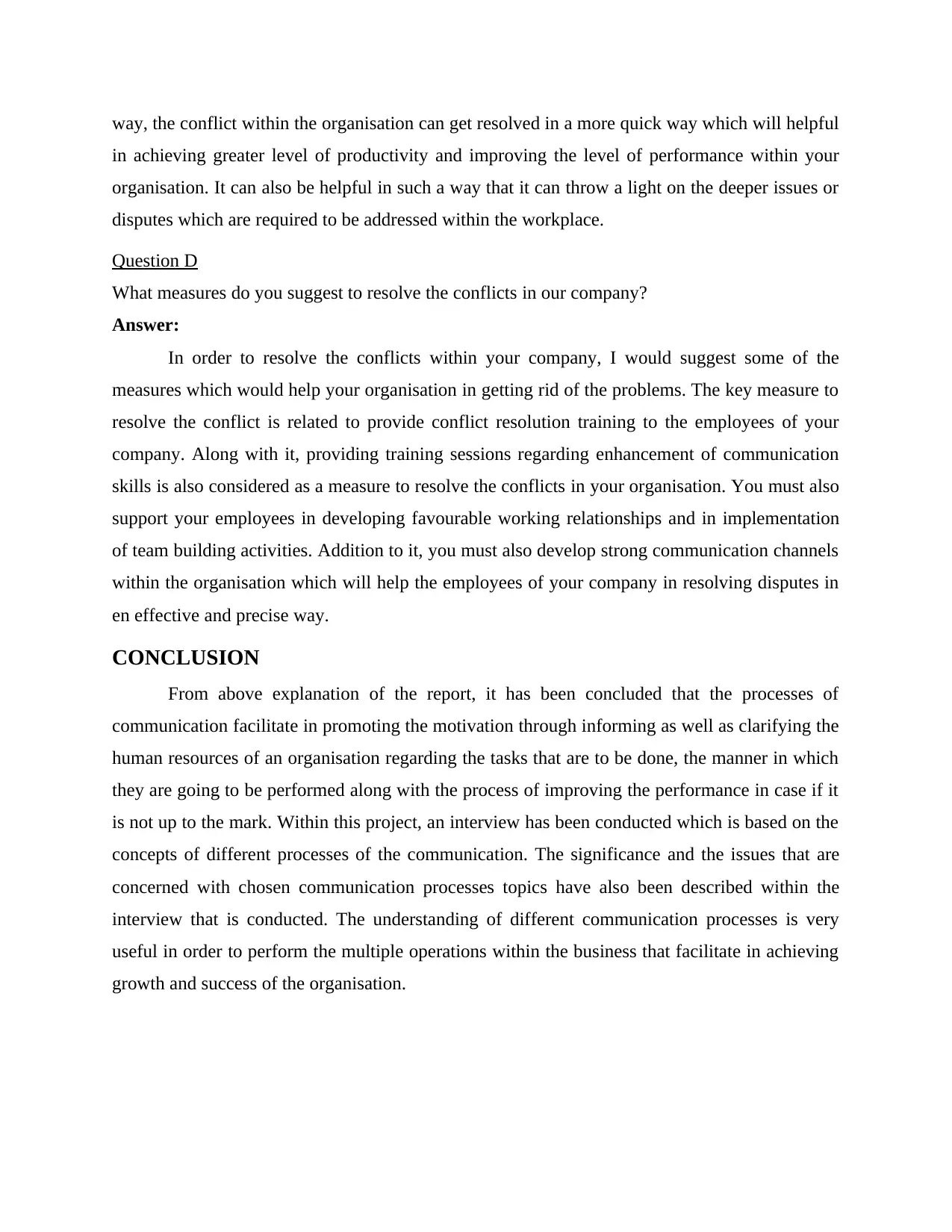
way, the conflict within the organisation can get resolved in a more quick way which will helpful
in achieving greater level of productivity and improving the level of performance within your
organisation. It can also be helpful in such a way that it can throw a light on the deeper issues or
disputes which are required to be addressed within the workplace.
Question D
What measures do you suggest to resolve the conflicts in our company?
Answer:
In order to resolve the conflicts within your company, I would suggest some of the
measures which would help your organisation in getting rid of the problems. The key measure to
resolve the conflict is related to provide conflict resolution training to the employees of your
company. Along with it, providing training sessions regarding enhancement of communication
skills is also considered as a measure to resolve the conflicts in your organisation. You must also
support your employees in developing favourable working relationships and in implementation
of team building activities. Addition to it, you must also develop strong communication channels
within the organisation which will help the employees of your company in resolving disputes in
en effective and precise way.
CONCLUSION
From above explanation of the report, it has been concluded that the processes of
communication facilitate in promoting the motivation through informing as well as clarifying the
human resources of an organisation regarding the tasks that are to be done, the manner in which
they are going to be performed along with the process of improving the performance in case if it
is not up to the mark. Within this project, an interview has been conducted which is based on the
concepts of different processes of the communication. The significance and the issues that are
concerned with chosen communication processes topics have also been described within the
interview that is conducted. The understanding of different communication processes is very
useful in order to perform the multiple operations within the business that facilitate in achieving
growth and success of the organisation.
in achieving greater level of productivity and improving the level of performance within your
organisation. It can also be helpful in such a way that it can throw a light on the deeper issues or
disputes which are required to be addressed within the workplace.
Question D
What measures do you suggest to resolve the conflicts in our company?
Answer:
In order to resolve the conflicts within your company, I would suggest some of the
measures which would help your organisation in getting rid of the problems. The key measure to
resolve the conflict is related to provide conflict resolution training to the employees of your
company. Along with it, providing training sessions regarding enhancement of communication
skills is also considered as a measure to resolve the conflicts in your organisation. You must also
support your employees in developing favourable working relationships and in implementation
of team building activities. Addition to it, you must also develop strong communication channels
within the organisation which will help the employees of your company in resolving disputes in
en effective and precise way.
CONCLUSION
From above explanation of the report, it has been concluded that the processes of
communication facilitate in promoting the motivation through informing as well as clarifying the
human resources of an organisation regarding the tasks that are to be done, the manner in which
they are going to be performed along with the process of improving the performance in case if it
is not up to the mark. Within this project, an interview has been conducted which is based on the
concepts of different processes of the communication. The significance and the issues that are
concerned with chosen communication processes topics have also been described within the
interview that is conducted. The understanding of different communication processes is very
useful in order to perform the multiple operations within the business that facilitate in achieving
growth and success of the organisation.
Paraphrase This Document
Need a fresh take? Get an instant paraphrase of this document with our AI Paraphraser
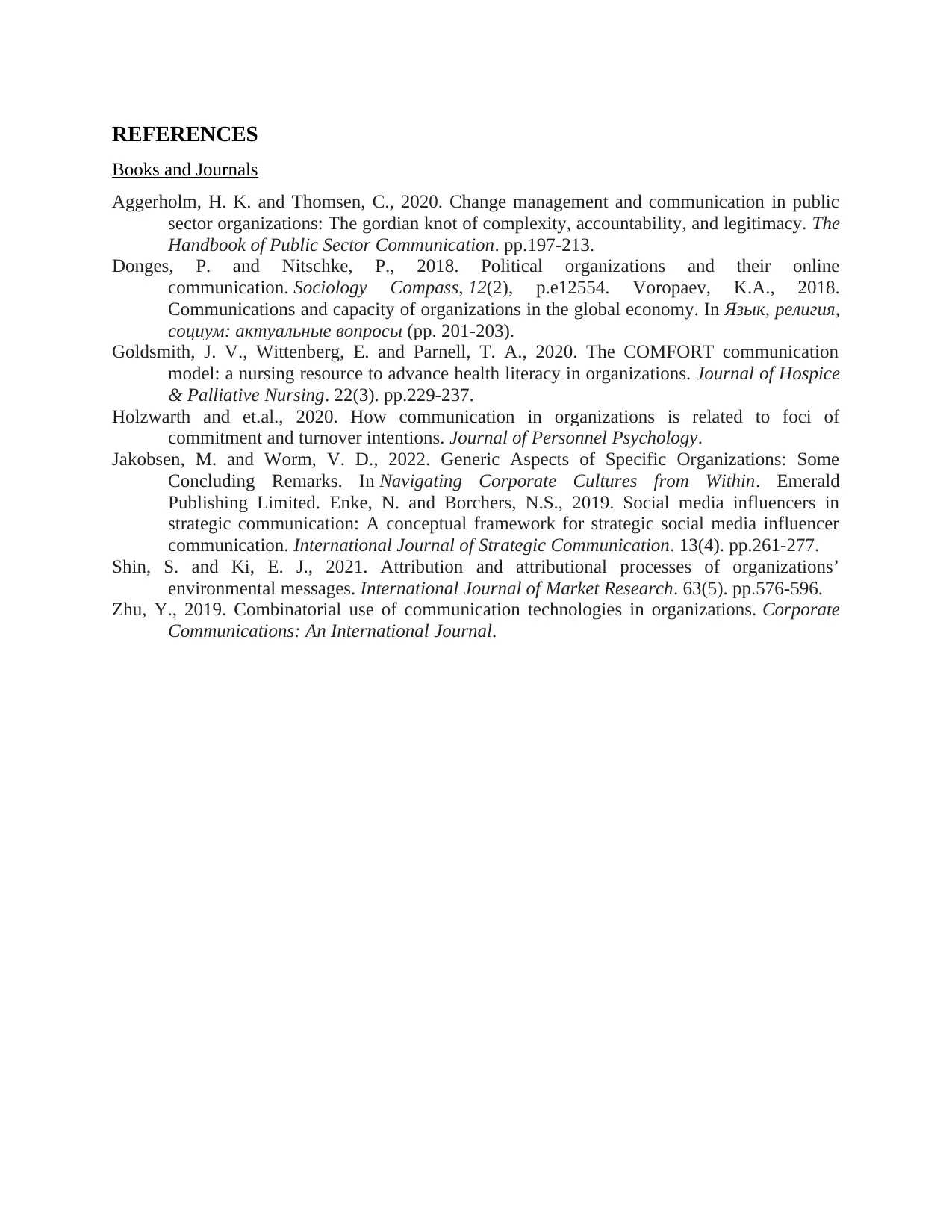
REFERENCES
Books and Journals
Aggerholm, H. K. and Thomsen, C., 2020. Change management and communication in public
sector organizations: The gordian knot of complexity, accountability, and legitimacy. The
Handbook of Public Sector Communication. pp.197-213.
Donges, P. and Nitschke, P., 2018. Political organizations and their online
communication. Sociology Compass, 12(2), p.e12554. Voropaev, K.A., 2018.
Communications and capacity of organizations in the global economy. In Язык, религия,
социум: актуальные вопросы (pp. 201-203).
Goldsmith, J. V., Wittenberg, E. and Parnell, T. A., 2020. The COMFORT communication
model: a nursing resource to advance health literacy in organizations. Journal of Hospice
& Palliative Nursing. 22(3). pp.229-237.
Holzwarth and et.al., 2020. How communication in organizations is related to foci of
commitment and turnover intentions. Journal of Personnel Psychology.
Jakobsen, M. and Worm, V. D., 2022. Generic Aspects of Specific Organizations: Some
Concluding Remarks. In Navigating Corporate Cultures from Within. Emerald
Publishing Limited. Enke, N. and Borchers, N.S., 2019. Social media influencers in
strategic communication: A conceptual framework for strategic social media influencer
communication. International Journal of Strategic Communication. 13(4). pp.261-277.
Shin, S. and Ki, E. J., 2021. Attribution and attributional processes of organizations’
environmental messages. International Journal of Market Research. 63(5). pp.576-596.
Zhu, Y., 2019. Combinatorial use of communication technologies in organizations. Corporate
Communications: An International Journal.
Books and Journals
Aggerholm, H. K. and Thomsen, C., 2020. Change management and communication in public
sector organizations: The gordian knot of complexity, accountability, and legitimacy. The
Handbook of Public Sector Communication. pp.197-213.
Donges, P. and Nitschke, P., 2018. Political organizations and their online
communication. Sociology Compass, 12(2), p.e12554. Voropaev, K.A., 2018.
Communications and capacity of organizations in the global economy. In Язык, религия,
социум: актуальные вопросы (pp. 201-203).
Goldsmith, J. V., Wittenberg, E. and Parnell, T. A., 2020. The COMFORT communication
model: a nursing resource to advance health literacy in organizations. Journal of Hospice
& Palliative Nursing. 22(3). pp.229-237.
Holzwarth and et.al., 2020. How communication in organizations is related to foci of
commitment and turnover intentions. Journal of Personnel Psychology.
Jakobsen, M. and Worm, V. D., 2022. Generic Aspects of Specific Organizations: Some
Concluding Remarks. In Navigating Corporate Cultures from Within. Emerald
Publishing Limited. Enke, N. and Borchers, N.S., 2019. Social media influencers in
strategic communication: A conceptual framework for strategic social media influencer
communication. International Journal of Strategic Communication. 13(4). pp.261-277.
Shin, S. and Ki, E. J., 2021. Attribution and attributional processes of organizations’
environmental messages. International Journal of Market Research. 63(5). pp.576-596.
Zhu, Y., 2019. Combinatorial use of communication technologies in organizations. Corporate
Communications: An International Journal.
1 out of 8
Related Documents
Your All-in-One AI-Powered Toolkit for Academic Success.
+13062052269
info@desklib.com
Available 24*7 on WhatsApp / Email
![[object Object]](/_next/static/media/star-bottom.7253800d.svg)
Unlock your academic potential
Copyright © 2020–2025 A2Z Services. All Rights Reserved. Developed and managed by ZUCOL.





